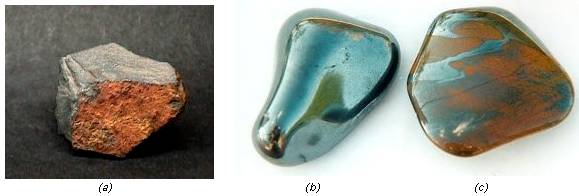| Haematite |
|
In simple terms a mineral is a collection of elements arranged in a particular structure and ratio. For example; 
Figure 2. (a) a sample of "paint ore" (b),(c) polished haematite samples |
|
Haematite is one of the most common minerals of iron, it's chemical formula is Fe2O3. That is, for every two atoms of iron there are 3 atoms of oxygen. The colour of most red rock, such as sandstone, is caused by small amounts of Haematite. When mineral formation takes place there are inevitably other elements in the area which may or may not become involved and as such these act as impurities. The most common impurity found in hematite is the element titanium.
Haematite is the principle ore of iron and is the source for roughly 90 percent of all iron mined in the United States. The picture below is a type of hematite known as iron rose. Minerals may form under a variety of conditions and this affects the type of structure that develops. "Paint ore" tends to be non-crystalline or made up of many tiny disorganised crystals however "Iron rose" is composed of flat hexagonal plates, hence the difference in their appearance. |